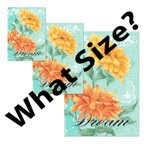 Ideally an artist that wants to license her/his art should create art the same size as the largest product the art will be placed. This is to insure that the art has good resolution and the image is not blurry. In practice that is not always practical. For instance, the artist may not know if the image will ever be licensed for large products such as 28 by 40 inch decorative flags. In that case it may not be worth the effort to create such large paintings, scan them in increments because they are too large to scan in one pass and then merge them into one image with Photoshop. Besides these files are large, time consuming to edit/save, and take up a bunch of storage space. In my opinion, it is better to create smaller sized art and enlarge them in photoshop as long as the quality of the art isn't too poor because of the lower resolution.
Ideally an artist that wants to license her/his art should create art the same size as the largest product the art will be placed. This is to insure that the art has good resolution and the image is not blurry. In practice that is not always practical. For instance, the artist may not know if the image will ever be licensed for large products such as 28 by 40 inch decorative flags. In that case it may not be worth the effort to create such large paintings, scan them in increments because they are too large to scan in one pass and then merge them into one image with Photoshop. Besides these files are large, time consuming to edit/save, and take up a bunch of storage space. In my opinion, it is better to create smaller sized art and enlarge them in photoshop as long as the quality of the art isn't too poor because of the lower resolution.So what is the correct art size? Well it depends because there is no standard size. Each artist needs to figure out what size works best for the products they license or hope to license. For instance, if an artist ONLY licenses greeting cards she/he most likely will create 5 by 7 inch art and scan and save it at 300dpi. Other artists may create art as large as their scanner will scan in one pass and save it at 300 or 600dpi.
I personally create art that is no smaller than 12 inches at 300dpi. Thus, I mostly create square/round art and patterns at 12 by 12 inches, vertical art at 12 by 16.8 inches (enlarged format of a 5 by 7 inch standard greeting card)*, and horizontal art at 16.8 by 12 inches. The reason why I use a minimum of 12 inches is because 1. artist/art director Joanne Fink recommends 12 inches when creating patterns for the scrapbook industry, and 2. I did some experimenting to see if a 12 inch Photoshop psd file when enlarged 2-1/3 times (size of a decorate flag - 28 divided by 12 = 2-1/3 times) is blurry when printed. It isn't. Or, at least not noticeably. Note: The reason why I create vertical and horizontal art in the formats stated above is because they are approximate dimensions for many products such as flags, gift bags and trays and can be easily edited to fit manufacturers specifications.
*There are several ways to figure out the dimensions of a document you wish to use.
1. You can calculate the dimensions. For instance, if you wish to enlarge a 5 by 7 inch format to 12 inches wide but don't know what the length should be, you divide 5 into 7 which equal 1.4. You then multiply the 1.4 by 12 to equal 16.8. Thus, the converted size would be 12 by 16.8 inches.
2. Another method is to use the image size command in Photoshop. Create a new 5 by 7 inch document in Photoshop. Go to Image/Image Size pull down menu. Make sure the Constrain Proportions box is checked. Change the width of the document from 5 to 12. The height is automatically changed to 16.8 inches. Thus, the new document size is 12 by 16.8 inches. Note: 16.8 inches is 16 inches and 8/10th of an inch.
What size of art do you create? Please comment in the below comment section.
Make sure to read the comments for additional useful information.






You can also use a good old fashioned proportion wheel to enlarge or reduce and not have to deal with tenths of inches. I love my proportion wheel. It has been a good and loyal friend.
ReplyDeleteGenuine Fractals Software does a good job of enlarging artwork when you might not have enough pixels otherwise.
ReplyDeleteThanks Andy for the information!
ReplyDeleteThe cost of the software is $160 and the website is http://www.ononesoftware.com/detail.php?prodLine_id=7
Joan